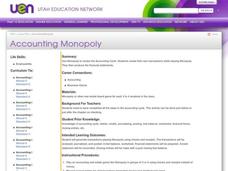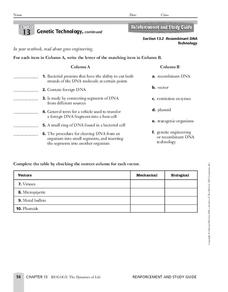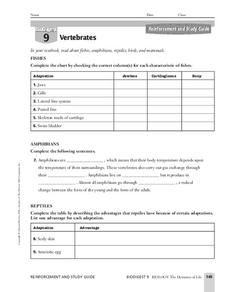Curated OER
4-H Line and Design: Intermediate Activity Page
In this 4-H line and design worksheet, students will complete a variety of design related activities. Students will use colored pencils to draw in the missing pieces of artistic photographs. Next, they will find and circle 6 art words in...
Curated OER
4-H Food Science- Intermediate Activity
In this nutrition worksheet set, students complete a dinner detective nutrient fill in the blank, a food safety true or false page, and plan a picnic with food safety rules in mind. They investigate careers that involve food safety.
Curated OER
4-H Food Science- Advanced Activity
In this advanced activity food science worksheet sets, students complete a food find word search puzzle, and practice food photography as they investigate it as a career. They examine food preservation methods through a food preservation...
Curated OER
Beef (Advanced)
In this beef worksheet, students participate in a variety of activities including completing a digestion dilemma, identifying best meat cuts and selecting a service project to complete.
Curated OER
Virginia Woolf
In this online interactive literature worksheet, students respond to 11 short answer questions about the life of Virginia Woolf. Students may check some of their answers on the interactive worksheet.
Curated OER
Is it Their, There or They're?
In this pronoun and homonym worksheet, students review the rules of when to use their, there and they're. Students then put the correct form of the word in the ten sentences given. In addition, the students summarize what homonyms are...
Curated OER
Respecting Differences
Fifth graders brainstorm what a relationship looks like in which both people respect each other. After completing a worksheet, they discuss the importance of respecting other beliefs. To end the activity, they identify things they can do...
Curated OER
Characteristics of Living Things
Seventh graders identify the characteristics of living and non-living things. In this biology lesson, 7th graders define vocabulary words as they go through the lesson. They answer a crossword puzzle after class discussion.
K12 Reader
Estimation
Teach your class a thing or two about making educated mathematical guesses. Learners read a passage that explains estimation and approximate and exact answers. They then respond to five questions about and related to the text.
Students Against Depression
Understand Your Depression
What are the warning signs of depression? What contributes to and maintains this disorder? Learners answer several short-answer questions regarding depression using a well-designed student packet. The lesson concludes by...
Curated OER
Accounting Monopoly
Students use Monopoly to review the accounting cycle. They create their own transactions while playing Monopoly. Students produce the financial statements that will match the transactions of the game.
Curated OER
Genetic Technology
In this genetic worksheet, students will match 6 terms associated with gene engineering to their correct definition. Then students will complete a table indicating if the vector is mechanical or biological. Finally, students will...
Curated OER
Vertebrates
In this vertebrate instructional activity, students review the different adaptations for the 5 groups of vertebrates: birds, mammals, reptiles, amphibians, and fishes. This instructional activity has 12 matching, 1 fill in the blank, and...
Curated OER
Eight Codes in Everyday Use
In this codes worksheet, students investigate eight codes used in everyday life. Fourteen activities are included as well as four miscellaneous exercise. This worksheet has great student interest.
Curated OER
A Day to Remember!
Students study math. For this real-life problem solving lesson, students work on their skills dealing with time and money. They work in small groups on various time and money word problems and by the final day they have a final problem...
Curated OER
Primate Evolution
In this primate evolution worksheet, high schoolers will review the structures and functions that are characteristic of primates. Students will identify the differences between Old World monkeys, New World monkeys, and prosimians. This...
Curated OER
Ratios, Mars and the Internet
Students calculate real ratios that exist between the planets Earth and Mars. After a lecture/demo, students use worksheets and access Internet sites to do their calculations.
Curated OER
Escape from Reality: Miro and Surrealism
Students examine the artwork of Joan Miro. In this art appreciation instructional activity, students research the life and work of Miro as a surreal artist. Students create their own surreal art as they follow Miro's techniques.
Curated OER
Setting Up Shop
Seventh graders investigate what goes in to starting a retail store. In this business economics instructional activity, 7th graders brainstorm products they would like to sell and use magazines, newspapers and real estate listings to...
Curated OER
America, A Home for Every Culture
Learners investigate the many cultures that are represented in America. In this American culture lesson, students look at the food, languages, music, and traditions that immigrants have contributed to the face of America. They complete...
Curated OER
WHAT DARWIN NEVER SAW: Evolution, Science, Biology, Natural Selection
Young scholars view video showing recent field work on a twenty two-year study of finch beaks on a small island in the Galapagos, showing natural selection clearly operating in the wild.
Curated OER
Flowerpots and Families
Students explore the importance of family communication and cohesiveness. In this family life instructional activity, students complete activities which demonstrate the characteristics of a strong family that is committed to...
Curated OER
One Trigonometry Rate Word Problem
In this trigonometry word problem worksheet, students calculate how close a ship comes to a lighthouse. The solution with explanation is provided.
Curated OER
Using I-Statements
Fifth graders brainstorm a list of life-changing events. As a class, they practice making I-statements and identify what to avoid when putting them together. To end the lesson, they determine which of their statements can be used in...























